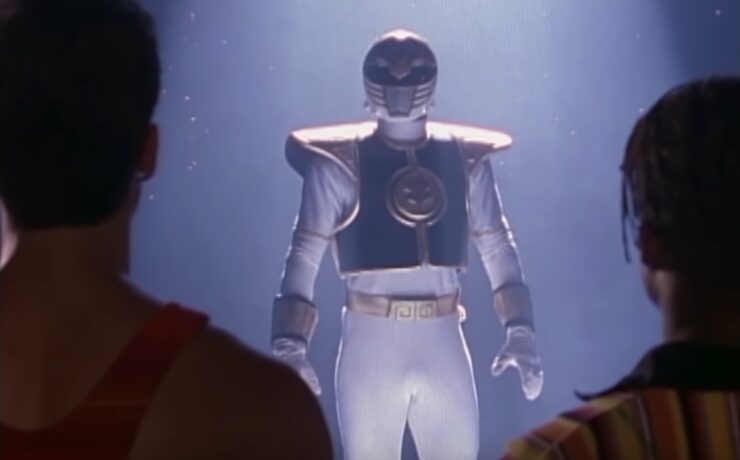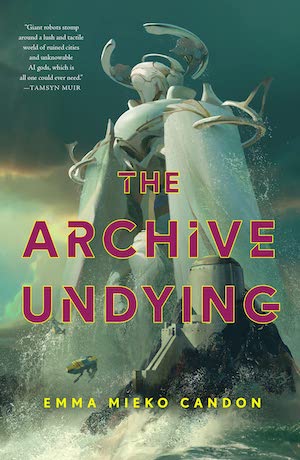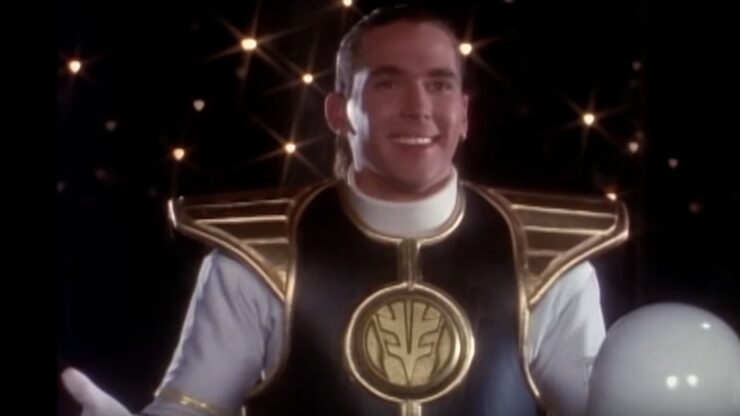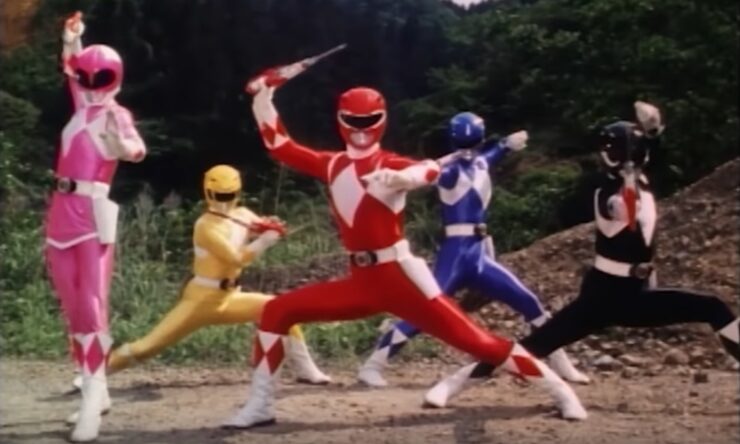(Glitch 1: My grandmother died last year, and, as I visit her grave, I imagine a large, robotic pterodactyl screaming through the overcast above, vibrating the hallowed ground on which I stand. This is weird, right? I stand, supposedly solemn, while my mind wanders further and looks to the skyline of Manhattan, just visible from St. Raymond’s Cemetery in the Bronx. A large, sentient lipstick or leaf or lizard lays waste to the skyscrapers.
Smash cut to a yellow mechanical sabertooth tiger bounding into action from the hills of Bayside, a blue triceratops on tank treads grinding through Williamsburg, a red Tyrannosaurus emerging out of the Hudson, a black mastodon, I don’t know, taking the ferry in from Staten Island? Look, it’s a daydream, but that’s not to minimize it. The Zords combine, and it’s curtains for the monster of the week. All of humanity is miraculously saved. The ordinary transforms into the heroic. I’m not supposed to be thinking about this here, but it makes sense if you dwell on it.
Thanks to a deregulated FCC and rampant Capitalism, media was essentially another grandparent. My grandmother, the one beside whose headstone I dream, brought me to this other one, and they both spoiled me. Countless trips to Toys ‘R’ Us. So many green boxes of robots and head-flippin’ action figures. Those head-flippers. They went from teenager to helmeted hero at the push of a button, and, when they did, they could beat anything. If I had a button, I’d flip my head into a superhuman that could beat the cancer that put my grandmother here. My head finds its way back. But I like to think these two grandparents are still working together, somewhere.)
//When Mighty Morphin Power Rangers premiered on August 28, 1993, it was decidedly not gay. It was five teenagers with attitude, a saucer-domed robot, and their floating dad-head who was eternally proud of them for fighting against an evil space witch. It’s rockin theme song made me feel like I had attitude, too. I wasn’t the kid who got their 5th Grade ass kicked while Safety Patrolling the vending machine. I was the kid who made quick work of the Putty Patrol through channeling friendship and instinctual martial arts. I was obsessed. My friends were obsessed. Maybe that’s why my experience of Mighty Morphin Power Rangers lasted beyond the thirty30 minutes per day it was on. It was the first piece of millennial media a group of four-to-five4-5 elementary school children could invest in together. As kids we learned, regularly, that some things weren’t for us. Mighty Morphin Power Rangers taught us that some things were.
For example, the show’s second season two-parter “White Light” captured my friends and me in its central mystery: Who is the White Ranger? This was big for a kid who felt so lost trying to comprehend plots written in assigned novels. My eyes could barely focus long enough to read the tiny letters much less make sense of the major dramatic question of, say, Where the Red Fern Grows, and I had the trail of failed reading tests to prove it. However, this was different. The White Ranger question was a visual one, inserted into a text my friends and I followed religiously. Tommy’s power as the Green Ranger had faded. Episode previews showed Zordon and Alpha working on a new ranger, while Tommy was suspiciously absent. No adult would understand what any of this meant, but we knew. When Tommy removed his white helmet in a sort of reverse Scooby Doo reveal, we Junior Power Rangers felt like we cracked the case long ago during our playground ponderings. The answer was almost irrelevant compared to the process of solving it. Mighty Morphin Power Rangers gave us a puzzle, and, in putting it together, we saw not just the White Ranger, but ourselves. We saw a reflection of the friend group that meant so much to us, pulled closer through a shared language. Fandom can do that. It can take the feelings of love and kinship we sometimes lack the vocabulary for and store them in banter about, say, Saba and the Tigerzord. The more fan jargon we trade, the more we glue ourselves to one another, and the only fee we pay for this bonding is a lasting attachment to a piece of media. I’d say that’s a bargain.

However, there is a catch. That mass of people, place, and time becomes a fixed point. While it is very much of the me I left in 1994, it isn’t, and can’t, be the story of my now. But the attachment to the show endures, and I bring to it new needs. Chiefly, I need it to explain my own transition. When I was thirty-two32, I went through my own “White Light,” except it was a solo show. After my powers were depleted, I found myself removing my own helmet, only to discover a restored self under it. That self was, and is, Non-Binary and Queer. It was, for me and the White Ranger, new colors on a familiar body. Different armor than before. I dug the new suit, but I had to ground it in my world. No longer did I don an outfit that matched the others on my team, but I assured myself that my essence was still just as rooted as theirs. If only I could figure out how. I looked around me for the oldest tools I had, and found one, the one, that had been with me since late summer twenty-five years earlier. The only problem was: that was a show that was, as I previously noted, decidedly not gay. Right?
Enter the Queer lens. You know the Queer lens. Maybe you’ve used it. Maybe your friends use it like it’s that one sauce they insist goes on everything. Maybe you’ve heard politicians legislate against it. You basically look through it, and, if you’re lucky, you’ll see yourself, or someone you love, standing on a piece of ground that now blossoms with Queer joy. I need to use this to view Mighty Morphin Power Rangers now. I need it because, when I grew up, where I grew up, there wasn’t much – nothing, in fact, that was allowed in my orbit – that could have loved me into the moment where I took off my own helmet. I need it because I want, so much, to hear the voices of my heroes seeing me, shouting, “Go, go. Go, go. Go, go” even despite the constraints of their scripted lines. The more I am able to embrace myself today, the more I want to find that hug for the younger me who didn’t have one. Plenty of people will swear I’m wrong, that this is in error, that it’s nothing more than a//
Buy the Book


The Archive Undying
(Glitch 2: When I learned, via an interview with him, that David Yost, the actor behind the Blue Ranger, wasis gay, I was shocked. I thought, for way too long, that decidedly not-gay media, the kind that made it through the cisheteronormative filter around me, could not house any form of Queerness. But there Yost’s identity was, the Trojan inside the horse. However, I don’t want to spin this into some heartwarming story of how you “can’t kill Queerness” [though you can’t]. Yost has spoken frequently of the homophobic abuse he endured on set, which ultimately led to his departure. There is no silver lining in that. But Yost’s coming out, and everything he has done since – from validating Instagram posts, to his identity-uplifting Affirmative Clothing Company, to his modeling of self-love – makes Mighty Morphin Power Rangers a place not just where I have lived, but where I can grow. And if his Queerness is there, against all odds, maybe mine is, too.)
In Glitch Feminism: A Manifesto, Legacy Russell levels the reality of online spaces with those that are away-from-keyboard (“AFK”) or offline. In doing so, she highlights Queerness as a “glitch” or error in a world with a cisheteronormative default. For example, in a timeline that expects a cis, straight man and a cis, straight woman will meet, fall in love, get married, and have children, Queerness will complicate those outcomes. This is not to suggest Queerness is wrong. On the contrary, Russell’s glitches allow Queerness to flourish, as they do in online spaces where avatars are sometimes used to explore Queerness that may put one in danger if realized AFK. Through Russell’s reframing of the word “glitch,” she creates further Queer Trojans inside the cis-filtered horse.
Scholar Becca Harrison uses this lens to look at media, specifically Star Wars. Her paper “Star Cistems Will Slip Through Your Fingers: Glitches, Malfunctions, and Errors as Modes of Queer Resistance in Star Wars” analyzes the moments of warped holograms, mistakenly unedited matte lines, and other banes of George Lucas’ existence in the sci-fi space opera as places where Russell’s Glitch Feminism can live. If one is to envision the film, then, as a body, it is a glitched one, and that, as Harrison and Russell would say, is also true of Queer bodies that remix and radically fail the cisheteronormative test given to them//
(Glitch 3: Three years ago, as the pandemic began, I decided to dump a bunch of money into my first Power Rangers cosplay. After a long period of brainstorming, I finally knew, for sure, which character I wanted to be. In Power Rangers lore, she was the White Aquitar Ranger from Mighty Morphin Alien Rangers, which filled out the lackluster tail end of Mighty Morphin Power Rangers’ third season. That character never quite blew me away, but, once I watched the Japanese show her footage was pulled from, she clicked. On Ninja Sentai Kakuranger, Ninja White is a girl who is the first female Sentai team leader. She has the most experience fighting the Youkai, or monsters of the show, and commands the mecha that, in the U.S. translation, would be the Zord piloted, for a short time, by Tommy Oliver, the [male] White Ranger.
This meant that Tommy, the machismo center of the Mighty Morphin team, was matched with a Zord whose movements were, at moments, quite soft and graceful. Both Ninja White and the White Ranger played to certain gender stereotypes, but the show, through the glitch necessitated by its format of repurposing Japanese footage, remixed them and created the Queer form I very much identify with. Everything I wanted to be was under her helmet. Roughly five years after I revealed my unmasked self to me, I put on hers and felt a warmth radiate toward my present from the arms I wrapped around the kid I left in 1993.)

If Harrison is right that finding Russell’s glitches is one way to apply the Queer lens to media, Mighty Morphin Power Rangers is rife with them. Because so much of the show was a low-budget re-hash of Japanese material, characters appear and disappear, props and costumes change from U.S. shots to their original counterparts, and settings change from rural to urban to back again depending on who was holding the camera. Even the title of the show, “Mighty Morphin Power Rangers,” is something of a glitch, with the word “Morphin” abandoning the apostrophe anticipated in dropped-G present participles. While the series is deeply meaningful and engaging, it is also, at many points, a radical technical failure. I don’t say this in the pejorative. I, too, am a radical technical failure. Every time I remix my masculine body with feminine dress, it becomes the cishet “failure” too many will tweet angrily about. But it’s criteria my body, and many like mine, take pride in failing. The “body” of Mighty Morphin Power Rangers fails it, too. In so doing, it assures me that one of my earliest worlds, one I was only permitted to experience because it was deemed glitch-less enough, saw me, loved me, and was, after all, cheering, “Go, go. Go, g//
(Glitch 4: I sit in the living room of my parents house in Knoxville, Tennessee, watching the final beats of Mighty Morphin Power Rangers. It’s 1995, and the show is about to end. My friends are there. As the episode winds down, there’s a palpable air of “What are we going to do now?” This is my first real experience with the ending of a thing. I don’t know if this means we, too, will go away. I don’t know if this means all of my toys will wander aimlessly without any new additions to keep their stories alive.
But, within the flash of a commercial, I am reminded that, yes, I have all I need. The bars of a distant theme song – “Goooooooooo Zeee-o” – echo through tales as old as time, through games of peek-a-boo and hide-and-go-seek, through the stories we keep telling over and over again because, without them, ourare nerves could not process a world about which we surely only know a fraction. The tune says, as so many have, that what has ended will be back again. What goes away resurrects in a recognizable form. And when it does, it is not our task to assess the changes in our stories, but those within our selves.)
//
Jonathan Alexandratos (they/them) is a New York City-based writer whose work often focuses on toys and pop culture. They make TikToks now @danceswithtoys.










